By Gabrielle See
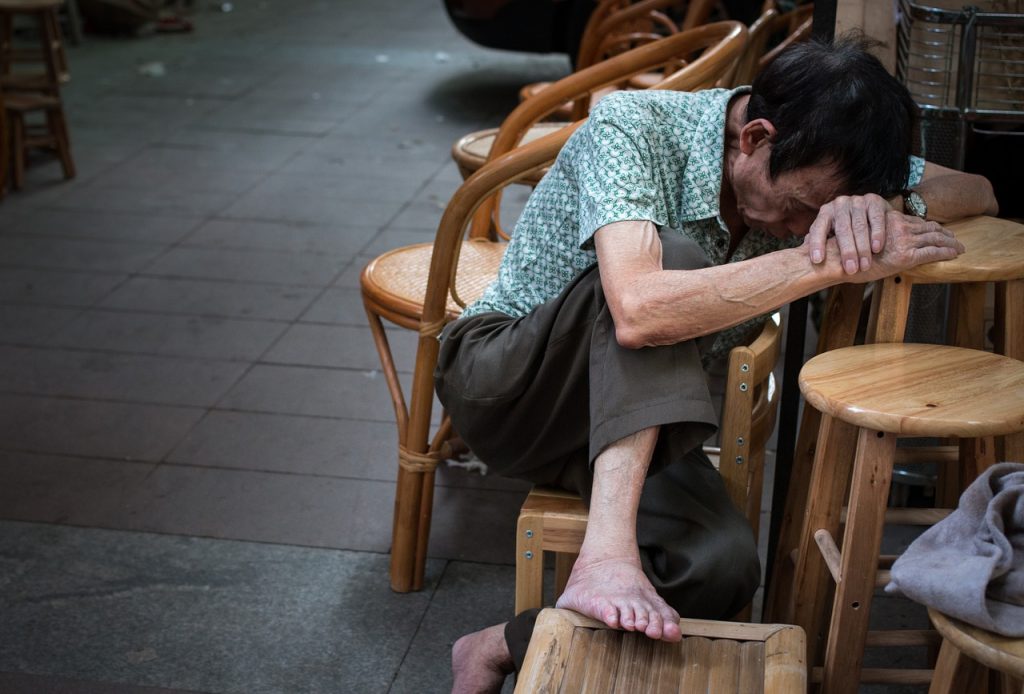
I first became interested in the topic of homelessness when I came across Amanda Swee’s final-year design project, in which she proposed the use of religious spaces for homeless individuals to rest at night.[*] At the time, the idea of “homeless Singaporeans” was very new to me, so that intrigued me to find out more. With this new awareness, I began to notice more of them—in hidden stairways, at dark corners under the void decks and on park benches. My first encounter with a homeless person took place earlier this year. My friend and I were heading out for lunch when a big-sized and scruffy-looking man called out to us. Middle aged and of Indian ethnicity, he was slumped over a flight of hidden stairs between two walls. “Please help me,” he said, as we made eye contact with him. Not knowing what to do at first, we walked away, but shortly after my friend and I decided to go back to check on him. It turned out he just wanted some lunch money. The above is not an uncommon scenario, but Ms Swee’s homelessness project and my personal encounter got me thinking more deeply about the issue. I wanted to know what the average Singaporean like myself could do to assist homeless people and how we can treat them with more dignity.
A Nation of Homeowners?
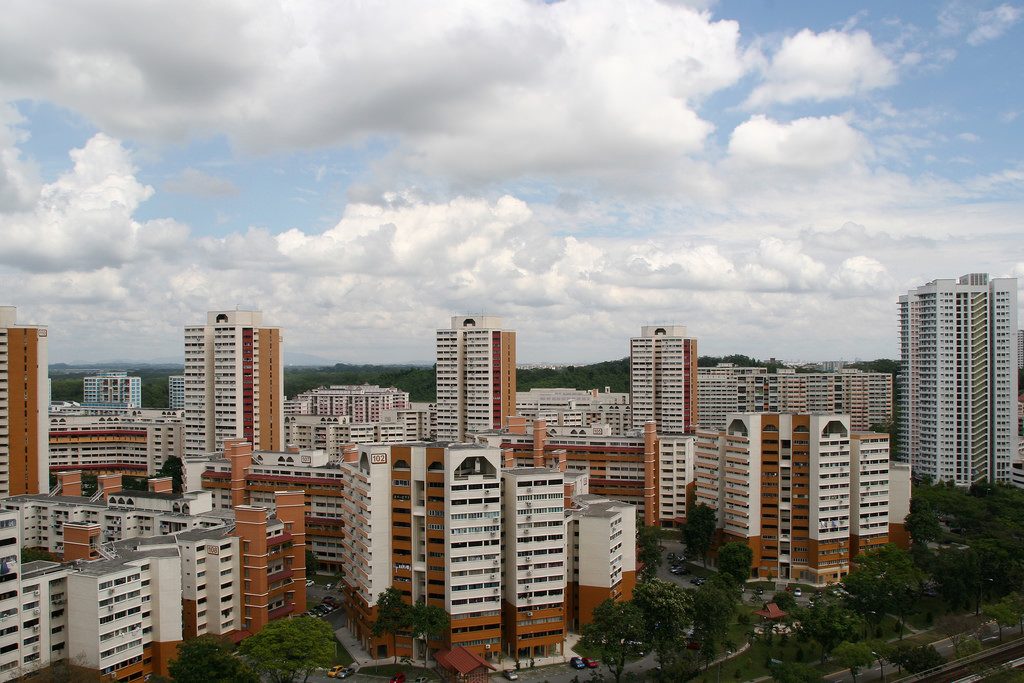
So the story goes: within a single generation, Singapore went from “third world to first” against all odds. Here, where citizens’ basic needs are met and a poverty line does not exist, the poor are considered “less badly off” than those in other parts of the world. And being a “nation of homeowners”, we can assume most will have a roof over their heads. However, although 80 per cent of Singaporeans live in HDB flats (government public housing), of which 90 per cent own their flats, and despite Singapore's global reputation for successful urban planning, homelessness exists. This begs the next question: what constitutes being homeless? In Singapore and around the world, there is no official or clear definition of homelessness. And since we have to first establish that a problem exists in order to solve it, quantifying homelessness becomes a tricky issue. At present, there are little to no available statistics regarding this under-examined group of people. To date, press coverage and research reports have mainly focused on the number of homeless people who received assistance from the Ministry of Social and Family Development (MSF) (an average of 300 cases per year). Less is known, on the other hand, about the actual numbers of homeless persons, including those with a registered address but who end up sleeping on the streets anyway.
Help for the Homeless: A Quick Glance
For purposes of this article alone, “homeless” persons will refer to Singaporeans who do not have permanent accommodation or are unable to use their registered address for various reasons including (but not limited to) estrangement from family and friends, choosing to be self-reliant or out of convenience. Homelessness can be categorised along the following spectrum of severity:
Most severe (on the streets → welfare homes → transitional shelters → interim rental housing) least severe
Government Housing Schemes/Assistance
Public Rental Housing: To be eligible, must not have bought and sold subsidised flats twice, 30-month debarment does not apply and total income must not exceed S$1,500 | Average waiting time (according to MSF): four months as of 2015
Joint Singles Scheme: Those eligible include first-timers for housing subsidies, both singles who are 35 years old and above, cannot have sold property 30 months before (after selling a HDB flat, formal owners are not allowed to apply for rental housing until 30 months have lapsed)
Interim Rental Housing: Managed by private operators | Two households to share a three-room flat | For those waiting for a new flat, public rental flat or waiting out a 30-month debarment period | Possible to extend tenancy period from six months to a year, which is renewable up to two years (unless they are waiting for a new flat or public rental flat, in which case they can renew their tenancy until the flat is ready)
Transitional Shelters: Three government-funded shelters: New Hope Shelter for Displaced Families and Individuals, Lakeside Families in Transition Shelter and Wahah Shelter | Allow people to stay for up to six months for as low as $50 a month | Total capacity of 156 families (120 families stayed in these shelters in 2014) | Reserved for those who have exhausted all means of accommodation | Official waiting time: Three days to a week
Welfare Homes: 12 welfare homes with total capacity of around 2,300 people: 1,250 for male destitute persons, 250 for female destitute persons and the remaining cater to both genders | Funded by MSF and managed by Social Service Organisations (SSOrgs) | For individuals who cannot work, have no financial means and do not have accommodation and family support
At present, because many government assistance schemes prioritise families with children or elderly parents over individuals, it is challenging for single men to receive support, even if they form the majority of homeless people. Renting a flat under the Public Rental Scheme (PRS) can also be challenging: combined monthly household income cannot exceed $1,500, and the applicant must prove all other means of assistance have been exhausted. But even for those who qualify, the waiting list is long and processing time can take up to four months, as of 2015. There is yet another subgroup of vulnerable people—the quasi-homeless, or those at risk of becoming homeless. For these individuals or families, their monthly wages are only enough to cover their rent, and should they lose their jobs or fail to meet their payments due to illness or other unforeseen circumstances, they face the very real prospect of losing a roof over their heads. Among this group are divorcees, single parents, as well as unmarried mothers and their children. To this end, women’s group AWARE has called on the HDB to relook its 30-month debarment period following the sale of a flat and more inclusive housing policies to prevent yet more cases of homelessness.
Painting a Picture of Homelessness
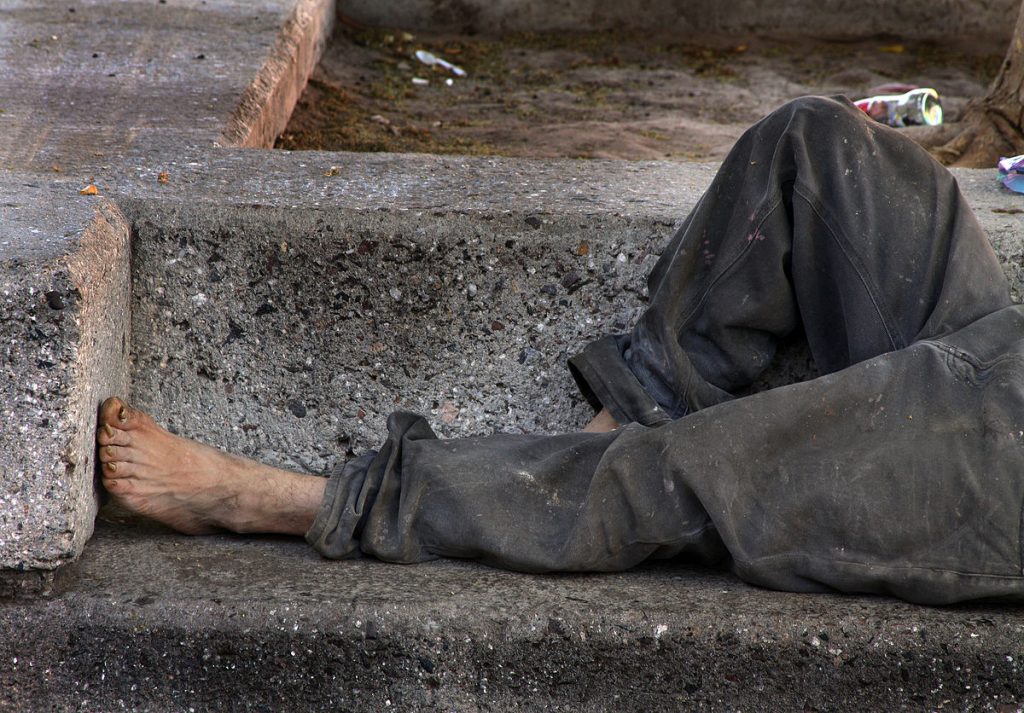
“Homelessness is not about being without a roof over one’s head. A home is not just a physical space. It provides roots, identity, security and a sense of belonging and a place of emotional well-being.”—Catholic Welfare Annual Report
Homeless individuals are commonly portrayed as victims of their own unfortunate circumstances or bad decisions. For instance, the author of this local news story suggests that the onus is on homeless persons themselves to be proactive about finding “right channels” of assistance, while in another article its writer reports that the authorities cannot render support if the homeless themselves choose to be self-reliant. In another piece, the journalist frames homelessness as a personal choice, citing cases of people opting to sleep in public spaces to reduce travelling time to work, or because they face housing issues or difficult relationships (with family or co-tenants). An academic paper published in Urban Studies journal affirms this observation that local print media seemed to suggest certain scenarios may predispose one towards destitution, including: a low level of education, financial problems, strained family relationships, and behavioural or addiction-related problems. When read together, such articles paint a familiar narrative about an individual’s choices and the circumstances contributing towards a homeless situation. However, a few other studies conducted by SSOrgs (including the Catholic Welfare Services and Montfort Care) have painted a broader picture. In their annual reports, the above-mentioned organisations mention the larger ecosystem of surrounding systemic factors and circumstances at play, such as a “lack of social support” as well as “structural barriers and challenges” facing social workers who assist homeless persons. But it is a 2017 survey conducted by volunteer group SW101 and Montfort Care that has truly challenged the prevailing narrative about homelessness in Singapore. In this study, 180 people were found sleeping in public spaces, more than half of whom hold jobs, and a quarter have a registered address to their names. Additionally, a sizeable number of them are young people.
Findings from Point-in-time Survey by SW101 and Montfort Care
* Conducted in March 2017
* Point-in-time count methodology is common in the US, Canada and Britain to monitor the homeless population * 180 people were found sleeping outdoors across 25 locations in Singapore
* Gender: 88% were men * Age: 61% were aged 50 and older; 24% were in their 20s to 40s
* Employment: 60% were working, with more than half (60%) holding full-time jobs (most common occupations were cleaners and security guards)
* Homeowners: around 25% have a registered address, often a rental flat under the Joint Singles Scheme (JSS)
* Education level: of the 74 who answered, 53% said they had primary school education or less, 40% had secondary school education, 8% had post-secondary certificates or diplomas
* Sought help from shelters: None
* Sought help in general: 20%
* 21 had been sleeping outdoors for more than a year (one-third of them had been sleeping in public over the last one to five years), 18 for more than five years (27% have been on the streets for over five years)
* Conditions: pest-infested, uncomfortable and urine-stained areas
Behind Their Struggles
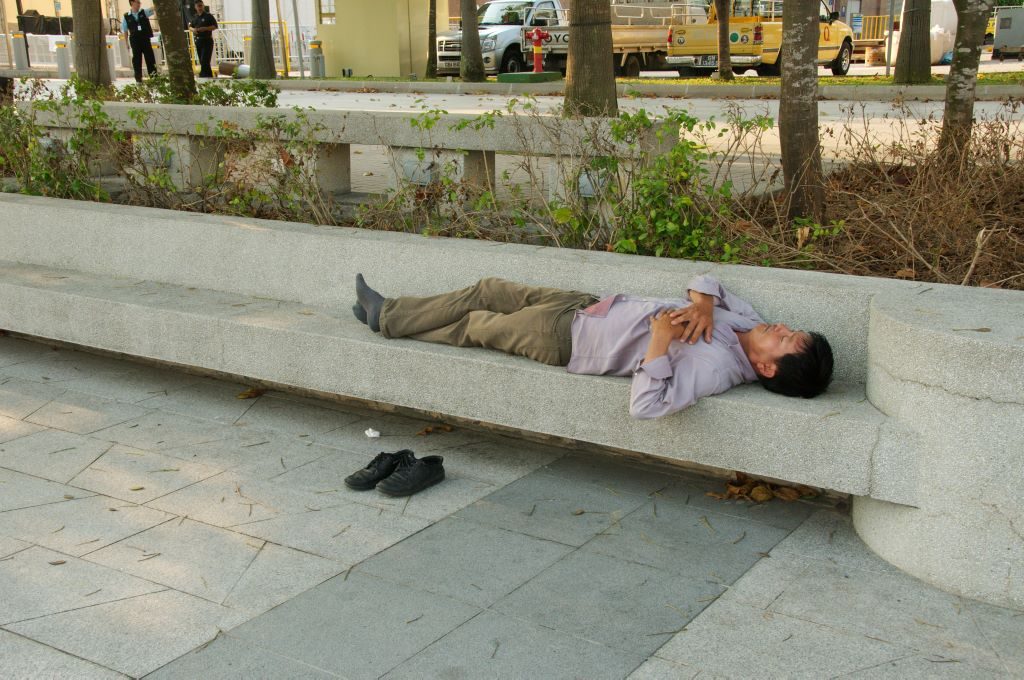
“Residual, highly selective, and strictly means-tested schemes have a tendency to incur social stigma because of the way they govern deservingness by requiring a demonstration of deficiency.” —Dr Ng Kok Hoe[†]
The results of the SW101 and Montfort Care survey challenged my previous held belief about homeless people—that the majority of them are unemployed or hold part-time jobs. I was surprised to learn that many in fact hold full-time positions as cleaners, security guards and so on. But because the pay is low and the nature of their work is unstable, this combination of low wages and irregular income makes home ownership and renting difficult. But it's the elderly homeless who're most affected by meagre salaries and job insecurity: with insufficient or no CPF funds, home ownership is not an option for many of them, who turn to renting in the open market or staying with family and friends. For individuals applying to get into a shelter home, they face long processing times—anywhere from three weeks up to six months, according to volunteer group Homeless Hearts of Singapore. While waiting, applicants have to find transitional shelters or, if they couldn’t afford the latter, they become homeless.
This situation backs what Dr Ng Kok Hoe, Assistant Professor at the Lee Kuan Yew School of Public Policy, believes about homelessness—rather than being a decision, homelessness “reflects that other more acceptable options are no longer available. It is a living arrangement that happens when there is no choice.”[‡] On this point, Dr Ng, who is part of the research effort behind the SW101 and Montfort Care survey, suggests that Singapore needs to change its existing approach towards homelessness, which has so far focused heavily on rehabilitation. He argues that this group of people do have the means to support themselves; it's just that these are limited. He thus identifies homelessness as a “larger issue related to economic opportunity and in-work poverty”.
During the writing of this article, I also met with Amanda Swee and her course mate Caitlin Foo, both of whom had done design projects addressing homelessness in Singapore. Speaking with them at their Graduation show, we discussed the reasons behind people habitually sleeping in public despite having a registered address. They brought up the Joint Singles Scheme (JSS) and the high possibility of social conflict resulting from two strangers sharing an apartment. Further, since many of these individuals are odd-job workers who have to report for work outside of the operating hours of public transportation, they have little option but to sleep in public areas near their workplaces instead. Finally, Ms Swee and Ms Foo added, if transitional housing and shelters aren’t worthy alternatives to homes, living on the streets can seem like a more attractive option. Both went on to describe the less-than-ideal conditions they’d witnessed in some instances: shelters so restrictive they’re “run like prisons”, and rental housing with poor natural lighting and bad ventilation.
Privilege, Dignity and the Destitute
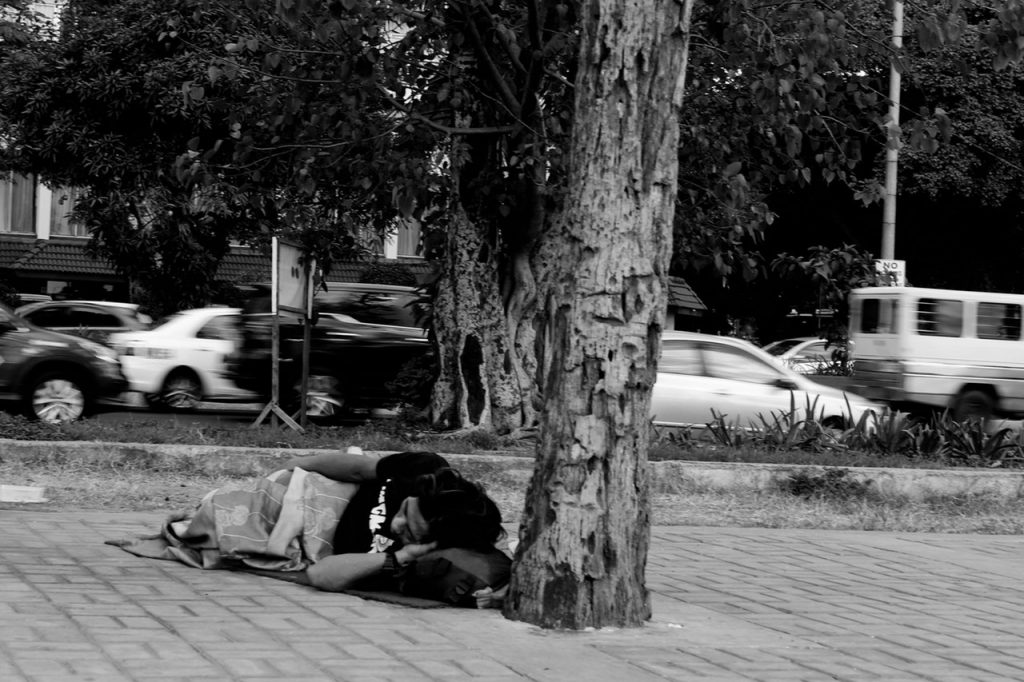
“How can we provide assistance without making those who need help feel that they have to prove that they have worked hard but not achieved enough and hence are worthy of support? Without feeling that they have no more dignity left?”—Nominated MP Kok Heng Leun
Many Singaporeans, myself included, are blind to their own privileged positions, as pointed out by Mr Kok Heng Lun in his recent parliamentary speech. “If we want to address inequality,” Kok claimed, “we must acknowledge the systemic factors that allow for unequal distribution of resources and opportunities. … [and] think deeply about how we have all—in some way or another—contributed to the persistence and growth of inequality.” In a meritocratic system that rewards “talent, effort and achievement” and where citizens are encouraged to be self-reliant rather than depend on state welfare, it’s easy to presume someone ends up destitute because of a lack of effort or due to poor life decisions. However, someone who inherited economic and social capital from their parents has privilege over another who didn’t, and stands to benefit more from such a system. In similar vein, it becomes clear that homelessness is likely a side effect of unfair systemic advantages (and disadvantages), but despite their lack of privilege, homeless people deserve to lead lives of dignity.
The two most fundamental needs within Maslow’s hierarchy of needs include physiological needs (food, clothing, shelter) and the need for safety/security. But although many destitute persons struggle to meet even these most basic requirements for human survival, the notion of the “self-reliant” Singaporean has made some homeless individuals refuse help even when it is sorely needed. I witnessed this first hand on a trip with the Homeless Hearts of Singapore. A lady I met seemed so “resigned to fate” that she said outright, “I know my place [in society]. I won’t bother all of you.” As a first step towards motivating them to rebuild their lives, we should first treat homeless persons with dignity. This is the view of both Brian Monteiro, a programme executive from Catholic Welfare Services, and Abraham Yeo, the founder of the Homeless Hearts of Singapore. In my conversations with them (on separate occasions earlier this year), both believed that while it is important to offer food and shelter, treating them with dignity will be what makes them feel needed and cared for. To this end, the Catholic Welfare Services occasionally outsources work to homeless persons “so they feel useful and needed”. Echoing this belief is Mr Derrick Wong of the Longer Table Initiative, who concurs that the homeless prefer getting jobs to asking for handouts. Wong, whose volunteer organisation distributes meals to the elderly in Chinatown, added that “a lot of them want to earn a living and not go to a social service office to ask for cheques”.
Homelessness: Where Do We Go From Here?
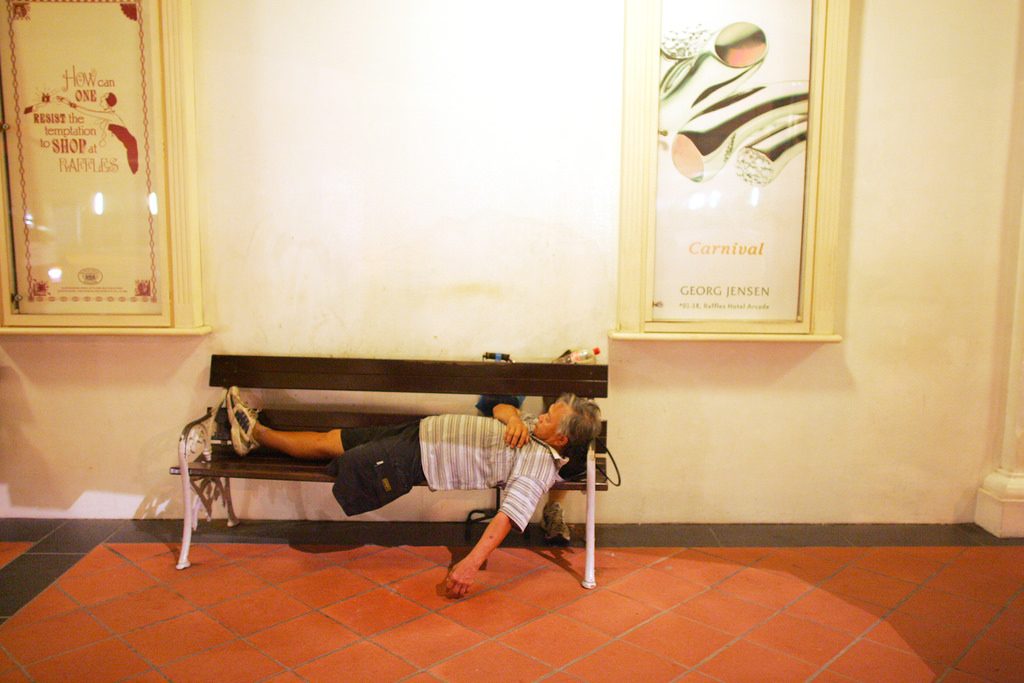
“It is important that in each society, the public and the people affected by homelessness have the opportunity to discuss and define what homelessness means in their context.”—Dr Ng Kok Hoe[§]
Although homelessness lacks a comprehensive, national definition, most people can agree on what it isn’t—for one, homelessness is not just about someone who lacks a registered address, since one can be homeless even with a house to their name. In addition to existing measures to tackling homelessness in Singapore, there is a need for greater coordination and dialogue between the relevant government departments, social service organisations and miscellaneous groups. While state agencies provide the structural scaffolding, SSOrgs and volunteers are well placed to interact with and understand the needs of homeless persons, as well as offer them emotional support. Rather than operating in silos, closer collaboration between all parties will prevent inefficiencies and duplication of work. Finally, we need more people, including the youth, academics, businessowners and industrial designers, to join in the dialogue about homelessness.
As mentioned at the beginning of this article, I was oblivious to the topic until I chanced upon Amanda Swee’s design thesis. Many younger people like myself are still unaware of the extent of homelessness in Singapore, and we need to bring it up more often in our everyday conversations with family, friends and co-workers. Specifically, we should not be afraid to discuss topics like welfare, a meritocratic system and social inequality, because they all intersect with the issue of homelessness in Singapore. While the topic is complex and there is no “one-size-fits-all” solution, more meaningful exchanges about the topic should be encouraged, especially in regard to destigmatising homeless persons and treating them with dignity.
“A family has basic material needs—food, shelter, clothing. Families and individuals also have need for social participation, for dignity and respect, for security, for information, for work-life balance. Every person also has needs for certain degree of autonomy and choice, so that he or she can exercise true agency.” —Dr Teo You Yenn, author of This is What Inequality Looks Like
Through this commentary, I hope I have made a strong enough case to encourage readers to take the first step of initiating a conversation about this issue. By bridging more conversations, we are sending an important message that the stories of homeless persons are just as important as anyone else’s, and that they belong in our wider narrative.
[*] Amanda Swee herself was inspired by her fellow course mate Caitlin Foo’s design project, also on homelessness.
[†] Author’s email correspondence with Dr Ng Kok Hoe, 19 June 2018.
[‡] Ibid.
[§] Ibid.
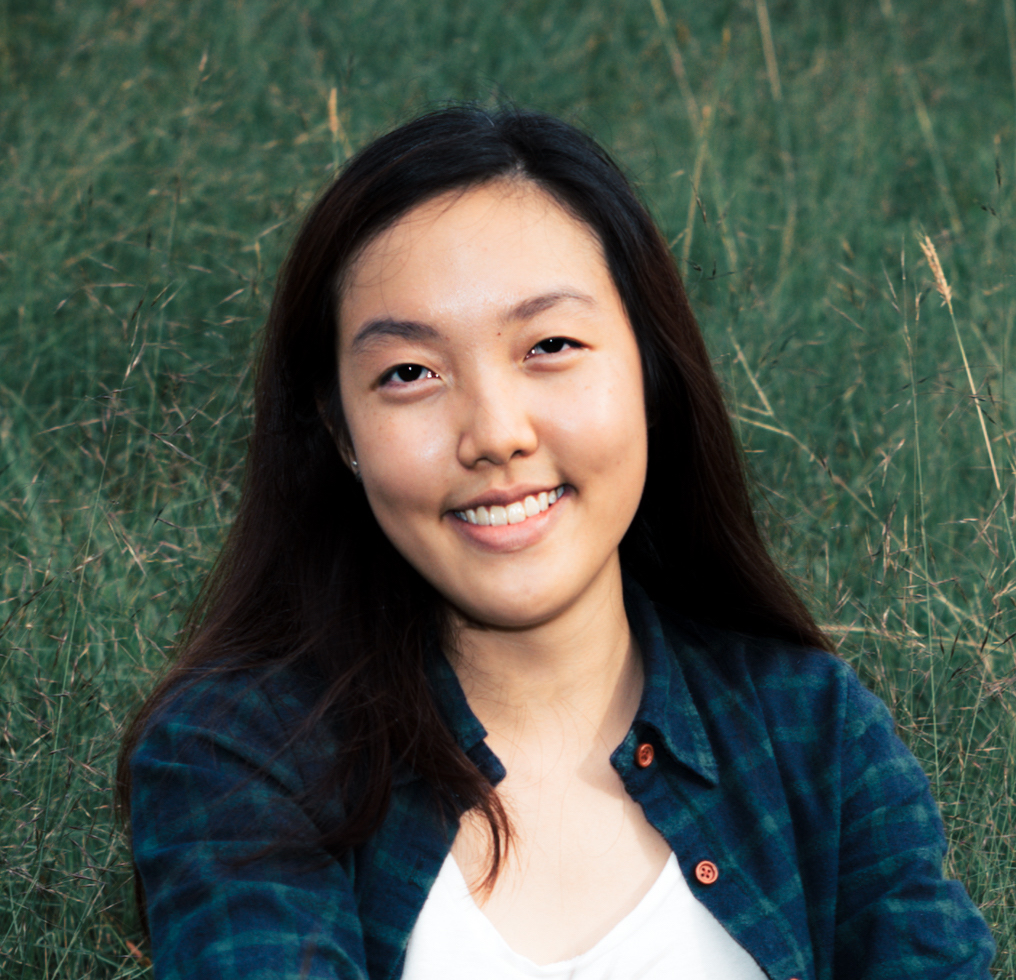 |
Gabrielle See was a 2018 Summer Associate (Editorial) at the Lien Centre for Social Innovation. She is a third-year undergraduate at the Singapore Management University, studying Politics, Law and Economics, with a second major in Economics. She loves making connections between seemingly incongruent things, analysing pop culture and is fluent in late-night talk shows. Gabby sees all knowledge as universal, transcendent and inextricably interconnected—a sentiment that has been espoused by Plato, Aristotle and Kant among other prolific thinkers through time. While she appears to be an amateur philosopher, she believes the accumulation of knowledge counts for nought if it does not spur action. An overseas community service project which brought her to Meru, Kenya in her first year left a lasting impression on her. She visited the office of Well Told Story, a media company creating social and economic value in Africa and it opened her eyes to how a well-researched and crafted publication can effect positive change in the community. She too aspires to be a contributor of such well told stories that change lives in the future. She can be reached at xmsee.2016@socsc.smu.edu.sg |




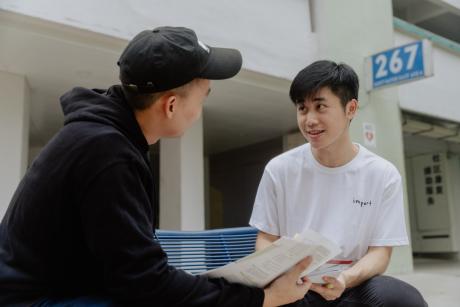



Comments